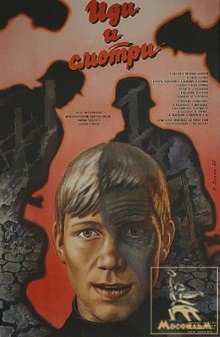
Each and every one of us has probably watched dozens of films about the Second World War but how many of them were from the Soviet point of view, by a predominantly Soviet cast and crew? Come and See is billed as a propaganda film because it was explicitly made to commemorate the 40th anniversary of the Soviet victory and to tell the world of the horrors inflicted in Belarus by German forces, a tragedy that the Soviets thought the world had ignored. Unlike so many such efforts however, under the direction of Elem Klimov, it was not only a commercial success but went on to be acknowledged as one of the best war films ever made.
In 1943, Belarus is under occupation by German forces. After scrounging for a rifle from a battlefield, a young boy Flyora is enthusiastic about joining the partisan forces that are resisting the invaders even while his mother cries that he is leaving her and her daughters to die. After he arrives at the encampment however he is assigned only to do menial tasks and the commander refuses to bring him along when they set off. He is joined by a girl who has also been left behind and they return to his home village while the camp is attacked by German bombardment and paratroopers. Being the kind of film that this, he arrives home only to find that his family together with much of his village has been massacred and this is only the beginning of the horror.
The camera spends an inordinate amount of time on the face of the young actor Aleksey Kravchenko who plays Flyora. More than any of the horrific sights that we see for ourselves, it is through his expressions that we feel our way through this film: his joy when he allowed to join in the partisans, his despair when he left behind, his anguish as he comes to terms with the fact that his family has died, his terror as death comes to him with seeming inevitability. Klimov remarked that he deliberately chose someone who had never acted before and immerse him in the horror so that we could see how a simple person reacts to it all. It can’t be denied that the technique worked but I’d consider it borderline unethical and it’s a wonder that the poor Kravchenko didn’t end up being permanently damaged by the experience.
Trauma is pretty much the watchword here and you’d be hard-pressed to find a single character in this film who is mentally sound. The great thing about Come and See is that it isn’t just mindless misery porn. Instead we see how the characters’ descent into madness is inexorable and inevitable due to events that are completely out of their control. It convinces us that anyone would be driven insane if they had to live through the same thing. The effect is enhanced further by the symbolic quality of the images. As my wife notes, the scenes don’t appear to portray literal truth but instead a kind of purified and distilled essence of what happened. As a result, the film is both almost unspeakably beautiful and terrible at the same time, like an animistic poem that taps into primal forces. To achieve all this, Klimov’s direction must be nothing short of flawless. As an example, some scenes are full of chaos with all manner of things happening at the same time and yet we must realize that all of this must be intended and therefore carefully orchestrated by the director.
Many, many war films try to say something about how war is hell but at the same time they almost never manage to avoid also playing up the valor of the soldiers fighting on their side of the war. It doesn’t take a genius to realize that their two approaches are in opposition with each other. If you want to sing the praises about how brave and great your heroes are, you can’t help but also acknowledge that there is something ennobling and glorifying about warfare. This is a big reason why American Sniper is such a miserable excuse as a supposedly anti-war film. I don’t understand how this is possible, but though Come and See is explicitly a propaganda film, it neatly avoids this trap.
An easy example of this is near the end of the film when the Soviet partisans attack and seems to completely defeat some German forces. The director could have chosen to film this battle in its entirety. He could have shown us the skill and tenacity of the Soviets as they fought against the Germans. He could have shown us how brave they are as ragged peasants fighting against an organized enemy with far superior equipment. Instead he shows us only the devastating aftermath of the battle when the Germans have already been defeated and he doesn’t pull any punches in showing what a sorry state the German soldiers soldiers have been left in and how pitiless the Soviets are towards them. If war is truly hell, then it is hell for both sides as this film seems to say. It’s true that the film portrays the Germans as invaders and that the Soviets are defending themselves and their homes. But the war doesn’t ennoble the Soviets or transform the partisans into saintly heroes. Instead, we come to understand how the massacres perpetrated by the Germans have planted a terrible hatred deep into the bones of the Soviets. In response, they do what they have to do to defend themselves and to take vengeance. But the experience is one that lessens them and forever damages them as human beings.
So yes, Come and See is one of the greatest war films ever made and should be required watching for anyone interested in seeing the Second World War from the perspective of the Soviet Union.
One thought on “Come and See (1985)”